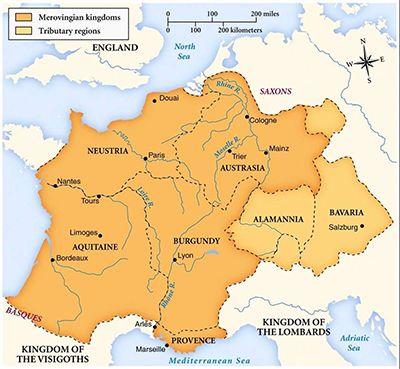The Merovingians
In the 3rd Century, the Franks migrated across the Rhine River. The Salian Franks emerged as the dominant tribe. In the mid-5th Century emerged a king named Chlodio, who paved the way for the Franks' first dynasty, the Merovingians. 
Chlodio's son Merovech was King of the Franks for a decade, from 447 to 457. It was from his name that the dynasty's name comes. His son Childeric I ruled until 482, and his son, Chlodovech I, succeeded him. This was Clovis (left), the first great Frankish king. Clovis was just 15 when he assumed the kingship. At that time, the Frankish capital was at Tournai, in what is now Belgium. Clovis proved a powerful warrior with a magnetic personality, able to inspire his fellow Franks to join him on a campaign of conquest. An early highlight of his reign was the defeat in 486 of the Gallic leader Sygarius, after which Clovis assumed ownership of Gaul. A decade later, the Franks had conquered the Alemanni as well. 
In 507, Clovis conquered the Visigoths, furthering extending his reign. He demanded tribute from the Burgundians, reducing them to subserviency. By this time, only a southern bit of land along the Mediterranean coast was still outside Frankish control. Clovis established his capital at the relatively centrally located Paris. It was there that he commissioned what would become the Salic Law, a codification of statutes regarding inheritance, migration, and punishment for crimes. Clovis died four years later, having achieved a large amount of territorial acquisition. The Frankish custom was that when a ruler died, whatever survived was divided between all of his surviving sons. This meant that when Clovis died, his four sons divided up all of the territory that he had won: Clotaire I was King of Soissons, Childebert I was King of Paris, Chlodomer was King of Orléans, and Theuderic I was King of Reims. Not for the first or last time, a division of power resulted in a struggle for supremacy. In this case, Clotaire emerged the sole ruler, in 558, after a lengthy on-and-off struggle with his brothers and their sons. He was King of the Franks for three years. 
After a period of uncertainty, the four divisions became three kingdoms: Burgundy, having been absorbed, was its own entity; the original settlement land was called Austrasia; the newly conquered lands were called Neustria. Those kingdoms operated as partially independent for many decades, during which a few rulers managed to unite them under one iron fist. For the most part, however, the power shifted from the king to his top lieutenant, who was known as the Mayor of the Palace. Subsequent power struggles were more and more between these officials and not between the kings themselves. Theudebert I in 534 was the first Frankish king to issue his own coins. (He was King of Austrasia.) Subsequent kings, of various kingdoms, followed suit. The next to rule all four Frankish kingdoms was Chlothar II, who achieved the feat in 613, after beginning as King of Neustria in 584. He ruled as King of the Franks until 629. Chlothar's oldest son, Dagobert I, did the same for another decade. Theuderic III was King of the Franks from 679 to 691; but this time, the king had much less power than before. Chlothar II, in 617, had elevated to a lifetime term the position of Mayor of the Palace. The holder of that office was essentially the kingdom's second-in-command. As the years went by, the Mayor of the Palace took over more and more of the duties of kingship. Theuderic's sons were also King of the Franks: Clovis IV ruled for three years and Childebert III ruled for 15 years. The latter's son, Dagobert III, was on the united throne for four years, ending in 715. His son Theuderic IV succeeded him and ruled until 737. The last of the united kings was Childeric III, who took the throne in 743. In 679, Pepin II became the Austrasian Mayor of the Palace and set his sights on consolidation. Eight years later, he was the leader of all the Franks. He deposed Childeric III in the process, thus ending the Merovingian dynasty. |
|
Social Studies for Kids
copyright 2002–2025
David White




